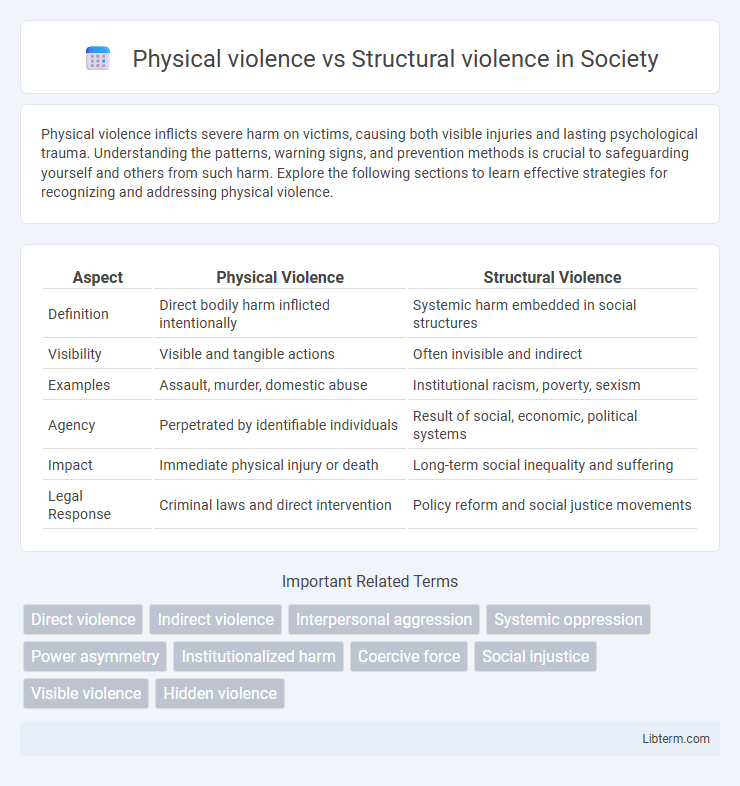Physical violence inflicts severe harm on victims, causing both visible injuries and lasting psychological trauma. Understanding the patterns, warning signs, and prevention methods is crucial to safeguarding yourself and others from such harm. Explore the following sections to learn effective strategies for recognizing and addressing physical violence.
Table of Comparison
| Aspect | Physical Violence | Structural Violence |
|---|---|---|
| Definition | Direct bodily harm inflicted intentionally | Systemic harm embedded in social structures |
| Visibility | Visible and tangible actions | Often invisible and indirect |
| Examples | Assault, murder, domestic abuse | Institutional racism, poverty, sexism |
| Agency | Perpetrated by identifiable individuals | Result of social, economic, political systems |
| Impact | Immediate physical injury or death | Long-term social inequality and suffering |
| Legal Response | Criminal laws and direct intervention | Policy reform and social justice movements |
Defining Physical Violence
Physical violence refers to the intentional use of force or power against another individual or group that results in bodily injury, pain, or impairment. It encompasses acts such as hitting, punching, beating, or any form of direct physical harm inflicted on a person. Unlike structural violence, which is embedded in social and institutional systems causing harm indirectly, physical violence is characterized by explicit, observable, and immediate harm to the victim's body.
Understanding Structural Violence
Structural violence refers to systematic ways in which social structures harm or disadvantage individuals, often embedded in institutions like education, healthcare, and legal systems. Unlike physical violence, which involves direct bodily harm, structural violence is indirect and insidious, manifesting through inequality, discrimination, and limited access to resources. Understanding structural violence requires analyzing how social, economic, and political frameworks perpetuate disparities that restrict human potential and well-being.
Key Differences Between Physical and Structural Violence
Physical violence involves direct bodily harm or force inflicted by an individual or group, such as assault, battery, or abuse. Structural violence is embedded within social, economic, and political systems, leading to systematic inequality, deprivation, and harm without direct physical aggression. The key difference lies in physical violence's visible, intentional acts versus structural violence's invisible, institutionalized patterns restricting access to resources and opportunities.
Historical Contexts of Violence
Physical violence involves direct acts of harm such as assault or warfare, while structural violence refers to systemic inequalities embedded within social, economic, and political institutions that marginalize certain groups. Historical contexts of violence reveal how colonialism, slavery, and institutionalized racism created lasting structural violence, perpetuating disparities even in the absence of overt physical aggression. Understanding these dynamics is crucial for addressing both immediate harm and underlying injustices that sustain violence across generations.
Impact on Individuals and Communities
Physical violence results in immediate, visible harm such as injuries and trauma, directly affecting individuals' mental and physical health. Structural violence, embedded in social systems and institutions, causes long-term disparities in access to resources, healthcare, and opportunities, profoundly impacting community well-being and social cohesion. Both forms perpetuate cycles of disadvantage, but structural violence often remains invisible, undermining individual potential and collective development over time.
Root Causes and Contributing Factors
Physical violence stems from immediate, observable acts causing bodily harm, often rooted in individual or group conflicts, social inequalities, and cultural norms that legitimize aggression. Structural violence arises from systemic inequalities embedded in social, economic, and political institutions, contributing to disparities in access to resources, power, and opportunities based on race, class, gender, or ethnicity. Both forms of violence intertwine as structural violence creates conditions that foster and perpetuate physical violence through poverty, marginalization, discrimination, and social exclusion.
Common Examples of Physical Violence
Common examples of physical violence include assault, battery, domestic abuse, and physical bullying, characterized by direct bodily harm or threat to an individual. These acts result in visible injuries and immediate physical suffering, often requiring medical intervention or law enforcement involvement. Physical violence contrasts with structural violence, which manifests invisibly through social systems that cause unequal access to resources and opportunities.
Real-World Cases of Structural Violence
Structural violence manifests through systemic inequalities embedded in social, economic, and political institutions, leading to disparities in health, education, and access to resources. Real-world cases include apartheid in South Africa, where legalized racial segregation imposed lifelong disadvantages, and the caste system in India, which perpetuates social exclusion and economic deprivation. Unlike physical violence, structural violence operates invisibly, causing chronic harm by restricting opportunities and reinforcing oppression.
Addressing and Reducing Violence
Addressing physical violence requires immediate intervention through law enforcement, community policing, and victim support services to ensure safety and justice. Reducing structural violence involves long-term policy reforms aimed at eliminating systemic inequalities in healthcare, education, and economic opportunities that perpetuate social harm. Effective violence reduction strategies integrate both immediate protective measures and comprehensive social policies to promote equitable and peaceful communities.
Moving Toward Social Justice and Equity
Physical violence involves direct bodily harm inflicted on individuals, whereas structural violence refers to systematic inequalities embedded in social institutions that hinder access to resources and opportunities. Moving toward social justice and equity requires dismantling these structural barriers through policy reforms, equitable resource distribution, and inclusive practices that address systemic discrimination and power imbalances. Empowering marginalized communities by amplifying their voices and fostering participatory decision-making is crucial for sustainable transformation and reducing both physical and structural violence.
Physical violence Infographic

 libterm.com
libterm.com